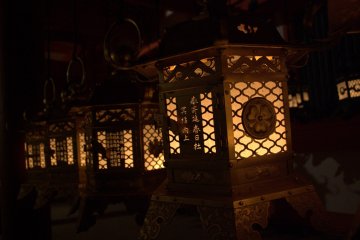

나라공원의 가장 안쪽에 있고, 코후쿠지(興福寺)나 도다이지(東大寺)에 낀 미카사야마(三笠山)기슭에 진좌한 가스가다이샤(春日大社)는 나라(奈良)의 심벌중 하나이다. 길게 뻗은 참도를 걸으면 사슴들이 풀을 뜯고, 사람들이 벤치에 앉아 책을 읽거나 소풍을 하거나 느긋하게 지내는 것을 볼 수 있다. 5월 등나무꽃의 달콤한 향기가 경내에 풍겼다. 신원인 만엽식물원에서는 20종류의 200여 송이의 등나무가 아름다운 꽃을 피우고 그 중원과 절분에는 조상의 공양과 소원성취를 기원하는 만토로(万燈籠)가 펼쳐진다. 매년 8월 14, 15일은 오후 7시경부터, 2월 3일은 오후 6시 반경부터 봉납된 3000기의 등롱에 불이 켜진다.

가스가 다이샤 사당은 고대 수도인 나라(나라)의 상징 중 하나이다. 사슴, 리스테리아, 3000개의 등불은 즐길 수 있는 하이라이트 중 하나이다.



Todai-ji Temple, also known as the Great Eastern Temple, was originally built in 752 at the behest of Emperor Shomu. It is one of the most famous and historically significant temples in all of Japan and one of the landmarks of Nara. The Todai-ji Temple is a UNESCO World Heritage Site. Until recently, the main hall of Todai-ji, Daibutsuden, was the largest wooden building in the world. The massive structure houses one of the largest cast bronze Buddha statues (Daibutsu) in Japan, which is 15 meters tall. Another popular attraction is a pillar with a floor-level hole that is exactly the size of the Buddha's nostril. Whoever manages to squeeze through this opening will supposedly reach enlightenment in the next life.

NARA Visitor Center & Inn is located by the Sarusawa Pond in Nara City, a short walking distance from Kintetsu Nara station and Nara station. It is the hub for all travel resources when visiting Nara. If you have any questions, need travel recommendations, or are looking for transportation guidance this is the stop to make. The visitor center offers services that will ease your travels in Nara. Find an ATM serving overseas cards and foreign currency exchange at the service counter. Drop your bags off at the baggage storage to rid the excessive weight off your shoulders as you explore the nearby areas. The travelers lounge is equipped with computers and i-pads available for use free of charge. If they are taken, use the free Wi-Fi, to start planning your adventure on your own devices. Find pamphlets and maps for basic information and tips on where to go. The multilingual staff are also extremely helpful and are happy to share the must-see sights and eats that you will not find in travel pamphlets. In addition to the many services offered here, you will find daily walking tours and free cultural activities to participate in. This is a great chance to learn and experience the art of Ikebana (flower arranging), dress in a Tempyo gown, or challenge yourself with Japanese calligraphy. Take the free excursion buses available every Tuesday, Thursday, Saturday and Sunday until October 31st, for a ride to either Asuka Village or Mount Yoshino. The famous sights and activities are not limited to Nara City so don't miss out on this opportunity to explore all the beauty Nara Prefecture has to offer!

Toshodaiji Temple, located just north of Yakushiji Temple in Nara, is a significant site related to the development of Buddhism in Japan and signifies a connection between Japanese and Chinese cultures. The prestigious temple was founded in 759 by the Chinese monk Ganjin, who traveled to Japan in 754 after being asked by the emperor to help train monks and improve Japanese Buddhism. After retiring, Ganjin was granted land and consequently, established Toshodaiji to continue teaching Chinese Buddhist principles. Today, the temple is recognized as a UNESCO World Heritage Site. Without a doubt, Toshodaiji’s most impressive structure is its Kondo, or Main Hall, which was reopened to visitors in 2009 after nearly ten years of reconstruction work. The one-story Kondo, situated directly behind the Nandai-mon (Southern Great Gate), is the epitome of early Japanese-Buddhist architecture with a tiled sloping roof, seven bays, columns, and dark wood tones. Due to the building’s columned facade, it is often compared to the Parthenon. Inside, the hall houses principal Buddhist statues, which are designated as National Treasures. Standing before the hall, you cannot help but be swept away by its commanding presence. Near the Kondo is the Kodo Lecture Hall. This structure was originally built as an administrative building for the Nara Imperial Palace, but later relocated to Toshodaiji after it was gifted to Ganjin. Today, the hall is the only surviving building of the palace, and thus, a historically significant and rare part of the temple. Another prominent temple building is the Miei-do, which enshrines a famous wooden sculpture of Ganjin that his disciples created using hollow-core, dry-lacquer techniques. The exclusive building is only open to the public for a few days a year around June 6th. For all other days, visitors can view a replica of the statue, which was made on the 1,250th anniversary of Ganjin’s death, on display at the nearby Kaizando. In the eastern woods of the precinct lies Ganjin’s grave, one of the most tranquil areas of the temple. Follow a nature-laden path through thick foliage and then cross over a small bridge into the peaceful haven. Toshodaiji is also home to monk sleeping quarters, storehouses for sutras and treasures, and the Koro (Shariden), which is the site of the Uchiwamaki Ceremony, or Fan Scattering Festival, on May 19. Be sure to visit this remarkable temple and walk the footsteps of one of the most influential Chinese monks of Japanese Buddhism.